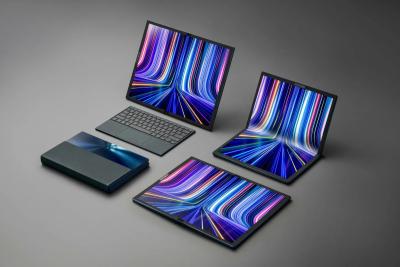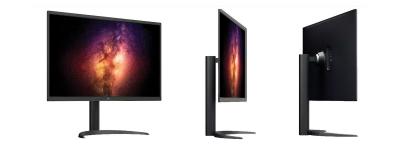Japan Display cancels its planned eLEAP OLED JV with HKC, now plans to produce panels itself in China
In 2022, Japan Display (JDI) announced that it has developed a "historic breakthrough in display technology" - a new OLED deposition process which they refer to as eLEAP, that is said to be cost effective and can be used to create freeform OLEDs that are brighter, more efficient, and longer lasting compared to OLEDs produced using mask evaporation (FMM).

Japan Display announced an agreement with China-based LCD maker HKC Corp to mass produce panels by 2025 in China, based on JDI's technology. But now it is reported that this joint venture is canceled. The report suggests that the two companies could not agree on a license fee that HKC was to pay to JDI. There is speculation that the HKC's canceled IPO and the slowdown in China's economy are to blame.
Japan Display aims to start eLEAP laptop OLED production by 2025
Japan Display (JDI) plans to start producing medium-sized OLED displays, to be used in tablets and laptops. The company hopes to start producing the first panels (which will be around 14-inch in size) by 2025.

Asus ZenBook 17 Fold OLED (BOE panel)
Up until now, JDI focused on the production of wearable OLED displays, selling its panels for Apple's smartwatches since 2019. The company's production volume was limited, and so was its technology capabilities to increase production panel sizes. It will be interesting to see whether JDI hopes to also supply its future laptop/tablet panels to Apple.
JDI announced it will acquire JOLED IP and some of its employees, but will not acquire its production facilities and technology
A few months ago we reported that Japan-based inkjet printing OLED developer JOLED has filed for bankruptcy, and that Japan Display (JDI) will take over JOLED's technology and operations. JDI released an official statement regarding JOLED and its plans for the future.

So indeed on March 7 2023, JDI signed a basic agreement to support JOLED. Since then the two companies held 'extensive discussions', following which JDI decided to form a subsidiary company called 'JDI Design and Development' or JDIDD, that will acquire JOLED’s OLED technology development business and all related operations.
HKC to start making AMOLED displays in collaboration with JDI using its eLEAP production technology
In 2022, Japan Display (JDI) announced that it has developed a "historic breakthrough in display technology" - a new OLED deposition process which they refer to as eLEAP, that is said to be cost effective and can be used to create freeform OLEDs that are brighter, more efficient, and longer lasting compared to OLEDs produced using mask evaporation (FMM).

We now hear that China-based LCD maker HKC Corp has signed an agreement with JDI to adopt its technology for mass production of AMOLED displays. Under the agreement HKC will invest billions to build AMOLED factories in China, while JDI will provide the manufacturing expertise and technologies, including eLEAP. The plan is to begin mass production in 2025, with the first applications to be in automotive displays and wearable devices.
JOLED files for bankruptcy, Japan Display to take over assets
A report from Japan updates that JOLED , the OLED inkjet printing pioneer established in 2014, has filed for bankruptcy. The company has been struggling financially for a long time, and will now close down its two production lines and lay off 280 employees (out of 380), as it could not raise funds and has liabilities of around $257 million.
According to the report, display maker Japan Display will take over JOLED technology and remaining operations.
A report suggests that Samsung Display is interested in JDI's eLEAP OLED deposition technology
A few months ago, Japan Display (JDI) announced that it has developed a "historic breakthrough in display technology" - a new OLED deposition process which they refer to as eLEAP, that is said to be cost effective and can be used to create freeform OLEDs that are brighter, more efficient, and longer lasting compared to OLEDs produced using mask evaporation (FMM).

According to a new report from Korea, Samsung Display is interested in JDI's new technique. Interestingly the report shows conflicting views within SDC - some are interested in adopting this new technology, especially at SDC's upcoming 8-Gen IT OLED production line, while others are more interested in preventing SDC's competitors (JDI, or others?) from using it, perhaps by pressuring OLED equipment makers to not offer needed equipment to JDI.
Japan Display announces a breakthrough lithographic-based OLED production method
Japan Display (JDI) announced that it has developed a new OLED deposition technology, which they refer to as eLEAP, that is cost effective and can be used to create OLEDs that are brighter, more efficient, and longer lasting compared to OLEDs produced using mask evaporation (FMM). eLEAP also enables OLED freeform deposition. JDI regards its new technology as a " historic breakthrough in display technology".

eLEAP is based on a lithographic method, and does not require any masks. The main advantage seems to be that OLED displays produced by eLEAP technology can achieve an aperture ratio of 60%, compared with FMM OLEDs which achieve a ratio of about 28%. This means that the OLED displays can be driven at lower currents - which extends the lifetime, improves the efficiency and also enables higher-peak brightness when needed.
DSCC details the OLED smartwatch panel market in 2020
DSCC posted an interesting chart that details OLED smartwatch shipments by supplier. This is an interesting market as there are almost 10 suppliers with no dominant player:
In fact DSCC says that there are five different OLED panel makers (BOE, SDC, LGD, EDO and Truly) that each has a market share over 10% in 2020.
JDI developed a new OLED production technology, looking for customer partners to commence mass production
Japan Display says it is developing a new OLED production technology that will enable higher resolution and higher efficiency OLED displays, and the company is in talks with potential customers regarding a joint investment in producing next-generation OLEDs.

According to JDI's CEO, the company is using a new manufacturing technology that is different to the evaporation method currently used by OLED makers. It is not clear what is meant by that - it could be an inkjet-printing technology (but achieving high resolution for smartphone displays with inkjet printing is a challenge) or something like OVPD or OVJP - or a new technology developed in-house at JDI.
Japan Display receives $935 million from Ichigo Asset Management
In August 2017, Japan Display announced a last-resort strategic focus on OLED displays as the Japanese display maker failed to shift to OLED displays in time. Since then JDI was busy trying to raise the funds needed to construct a large-scale OLED fab, raising $430 million from Oasis Management group and one of its customers (likely to be Apple).
As was discussed earlier, JDI now confirmed that Ichigo Asset Management will invest up to 100.8 billion yen (around $925 million) in JDI, and secure a stake of over 50% in JDI.
Pagination
- Previous page
- Page 2
- Next page


